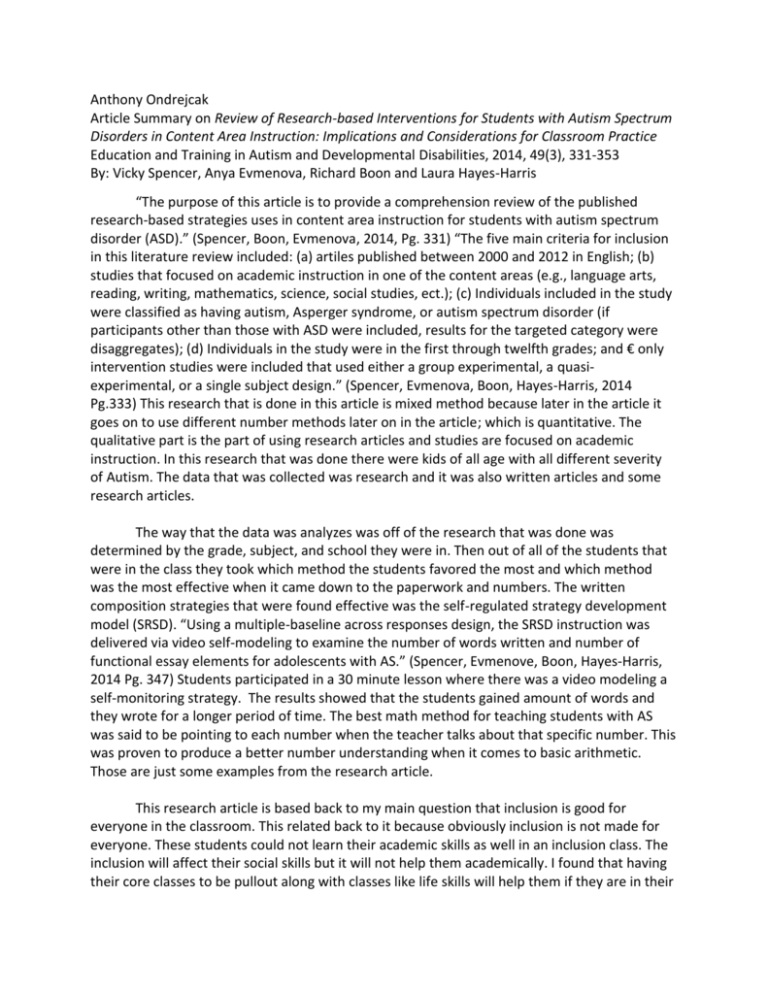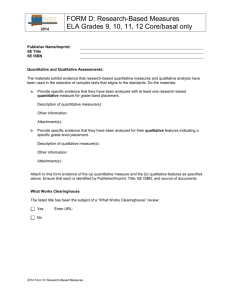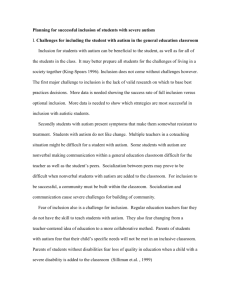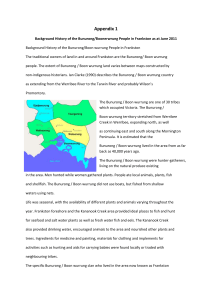Anthony Ondrejcak Article Summary on Review of Research
advertisement

Anthony Ondrejcak Article Summary on Review of Research-based Interventions for Students with Autism Spectrum Disorders in Content Area Instruction: Implications and Considerations for Classroom Practice Education and Training in Autism and Developmental Disabilities, 2014, 49(3), 331-353 By: Vicky Spencer, Anya Evmenova, Richard Boon and Laura Hayes-Harris “The purpose of this article is to provide a comprehension review of the published research-based strategies uses in content area instruction for students with autism spectrum disorder (ASD).” (Spencer, Boon, Evmenova, 2014, Pg. 331) “The five main criteria for inclusion in this literature review included: (a) artiles published between 2000 and 2012 in English; (b) studies that focused on academic instruction in one of the content areas (e.g., language arts, reading, writing, mathematics, science, social studies, ect.); (c) Individuals included in the study were classified as having autism, Asperger syndrome, or autism spectrum disorder (if participants other than those with ASD were included, results for the targeted category were disaggregates); (d) Individuals in the study were in the first through twelfth grades; and € only intervention studies were included that used either a group experimental, a quasiexperimental, or a single subject design.” (Spencer, Evmenova, Boon, Hayes-Harris, 2014 Pg.333) This research that is done in this article is mixed method because later in the article it goes on to use different number methods later on in the article; which is quantitative. The qualitative part is the part of using research articles and studies are focused on academic instruction. In this research that was done there were kids of all age with all different severity of Autism. The data that was collected was research and it was also written articles and some research articles. The way that the data was analyzes was off of the research that was done was determined by the grade, subject, and school they were in. Then out of all of the students that were in the class they took which method the students favored the most and which method was the most effective when it came down to the paperwork and numbers. The written composition strategies that were found effective was the self-regulated strategy development model (SRSD). “Using a multiple-baseline across responses design, the SRSD instruction was delivered via video self-modeling to examine the number of words written and number of functional essay elements for adolescents with AS.” (Spencer, Evmenove, Boon, Hayes-Harris, 2014 Pg. 347) Students participated in a 30 minute lesson where there was a video modeling a self-monitoring strategy. The results showed that the students gained amount of words and they wrote for a longer period of time. The best math method for teaching students with AS was said to be pointing to each number when the teacher talks about that specific number. This was proven to produce a better number understanding when it comes to basic arithmetic. Those are just some examples from the research article. This research article is based back to my main question that inclusion is good for everyone in the classroom. This related back to it because obviously inclusion is not made for everyone. These students could not learn their academic skills as well in an inclusion class. The inclusion will affect their social skills but it will not help them academically. I found that having their core classes to be pullout along with classes like life skills will help them if they are in their own classroom. I also think that classes like music, gym and art can be very helpful to the students for physical, social and fine motor skills. 1. 2. 3. 4. 5. 6. 7. 8. Research Question(s)- THEY MUST BE WORD FOR WORD from the research article, included in quotation marks in your summary with a direct quote citation (Author’s last name, year of the publication, p.#) Type of Research- Qualitative and/or Quantitative- and WHY you believe the research is either qualitative, quantitative, or mixed methods (on some rare occasions you will find research that is qualitative AND quantitative) Participants- who participated in the research, ages, sex, race, etc. that is relevant to the research questions Data Collection Method- survey, questionnaire, interviews, focus groups, ethnography, case studies, etc. and a brief description of it Data Collection Process- describe HOW the researcher used the data collection method addressed above (i.e. a survey was distributed via an email list serve to a Survey Monkey link, etc.) Data Collected- quantitative or numeric data and example questions from a survey, interview, types of observations, etc. or even snippets of the data described in the article (NOTE: if they are word for word descriptions of the data from the author make sure you use quotations and a direct quote citation) Data Analysis- briefly describe how the data was analyzed Findings- describe the findings of the research based on the report from the author in your research article Relevance to YOUR Research Question(s)- describe how the findings and this research relates to YOUR research topic and question(s) and how effective you believe the research article to be and why, and do you believe this was effective use of these research methods – qualitative and quantitative, etc., and possible limitations








